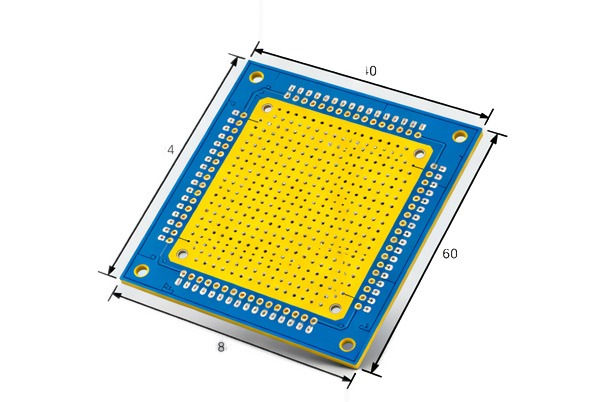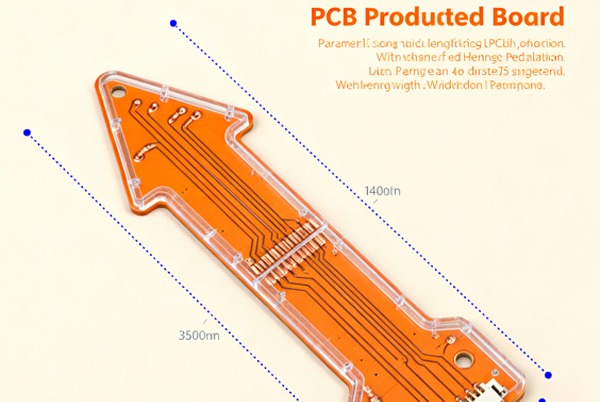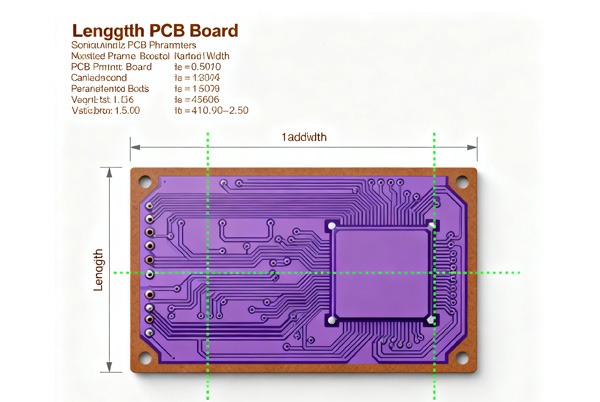Table of Contents
What is PCB aspect ratio?
Aspect Ratio – the ratio of the thickness of a PCB to the diameter of the drill bit used.
Aspect Ratio = Board Thickness / Drill Hole Diameter
For example, for a PCB with a thickness of 2.0mm and a mechanically drilled through-hole of 0.2mm in diameter, the aspect ratio would be 2.0 / 0.2 = 10:1.
A higher aspect ratio indicates a deeper and narrower hole, which increases the difficulty of processing.
The PCB Aspect Ratio is a key parameter used to evaluate the difficulty of the drilling process and the reliability of the printed circuit board. It is defined as the ratio of the hole depth to the hole diameter, calculated as:
Aspect Ratio (AR) = Hole Depth / Hole Diameter
Definition and Calculation Formula
The aspect ratio directly reflects the depth-to-diameter relationship of a drilled hole. For instance, a hole with a thickness of 1.6mm and a diameter of 0.2mm has an aspect ratio of 8:1 (1.6/0.2). This parameter influences plating uniformity, signal integrity, and mechanical strength, making it a critical indicator in PCB design and manufacturing.
Typical Aspect Ratio Values
- Through-Holes: In conventional designs, the aspect ratio is generally kept within 10:1. Values exceeding this require feasibility assessment for manufacturing.
- Microvias: In high-density interconnect (HDI) designs, microvias (with diameters ≤ 0.2mm) can achieve aspect ratios of 5:1 or higher. Laser drilling technology even supports high aspect ratios of up to 20:1.

How to Determine the Aspect Ratio of a PCB
The aspect ratio (also referred to as the thickness-to-diameter ratio) of a PCB is defined as the ratio of the board thickness to the diameter of the smallest via. It is calculated using the formula:
Aspect Ratio = Board Thickness / Drill Diameter
For example, for a board thickness of 1.6mm and a drill diameter of 0.2mm, the aspect ratio is 8:1.
Key points are as follows:
Recommended Range
- The industry generally recommends a maximum aspect ratio of 10:1. Exceeding this value requires confirmation of the supplier’s process capability.
- For blind vias, the aspect ratio is typically advised to be kept below 1:1 to avoid manufacturing issues.
Impact and Design Considerations
- A lower aspect ratio (e.g., < 10:1) facilitates better plating uniformity, improves resin filling quality, and enhances production yield.
- A higher aspect ratio increases drilling and plating difficulty, which may lead to higher costs.
- Designers should balance technical requirements (such as signal integrity) with cost considerations.
Calculation Examples
- Board thickness: 2.4mm, hole diameter: 0.3mm → Aspect Ratio = 2.4 / 0.3 = 8:1
- For microvias, the aspect ratio is calculated based on the actual drilling depth and diameter.
By properly controlling the aspect ratio, PCB manufacturability, reliability, and cost-effectiveness can be optimized.
How to Choose the Appropriate PCB Aspect Ratio
Selecting the right PCB aspect ratio requires a comprehensive consideration of industry standards, design types, and manufacturing process capabilities. Below are the key points and recommendations:
1. Industry Recommended Maximum Aspect Ratio: 10:1
- Through-Hole Design: It is generally recommended to keep the aspect ratio (board thickness/drill diameter) below 10:1. For example, if the board thickness is 1.6mm, the drill diameter should not be less than 0.16mm. Exceeding this ratio requires evaluating the supplier’s process capability; otherwise, it may affect plating uniformity and structural reliability.
- Balancing Cost and Reliability: A higher aspect ratio (e.g., 6:1–10:1) can improve signal integrity and thermal performance but also increases plating difficulty, leading to risks such as uneven plating thickness or even fractures, while also driving up manufacturing costs.
2. Blind Via Design Requirement: Aspect Ratio ≤ 1:1
- Blind Via Rule: The aspect ratio for blind vias should be ≤ 1:1 to ensure plating quality. For example, if the via diameter is 0.2mm, its depth should not exceed 0.2mm; otherwise, defects like incomplete plating or voids may occur.
- HDI Applications: Blind vias are commonly used in high-density interconnect (HDI) designs to save routing space, but their dimensions must be strictly controlled, and the resulting process complexity must be managed.
3. Plating Uniformity and Cost Control
- Plating Challenges: High aspect ratio through-holes are prone to the “dog-bone effect,” where plating is thicker at the via entrance and thinner in the middle. Processes like pulse plating can be used to optimize current distribution and improve plating uniformity.
- Material and Process Compatibility: It is advisable to select substrates with a low coefficient of thermal expansion and pair them with laser drilling technologies (e.g., CO₂ laser) to reduce the heat-affected zone. Note that CO₂ lasers are generally suitable for blind vias with diameters ≥50μm, and selection should consider specific design requirements and costs.
4. Comprehensive Design Recommendations
- Conventional Designs: It is recommended to use through-holes with an aspect ratio ≤10:1, balancing performance needs with manufacturing costs.
- High-Density Designs: If blind vias are used, strictly adhere to the 1:1 aspect ratio limit and evaluate the additional costs associated with HDI processes.
- High-Frequency/High-Reliability Scenarios: It is recommended to use signal integrity (SI) analysis and design rule checks (DRC) to validate the feasibility of high aspect ratio designs in terms of electrical and mechanical performance.

How to Improve Plating Uniformity in High Aspect Ratio PCBs
Optimizing plating uniformity in high aspect ratio PCBs requires a systematic approach across multiple dimensions, including process parameters, equipment configuration, fluid dynamics design, plating solution formulation, and quality monitoring. Below are the key optimization directions and specific measures:
1. Process Parameter Optimization
- Pulse Plating Technology
Replace traditional DC power with pulsed current. By alternating between high-peak current and low/zero current modes, the current distribution within the holes is effectively improved, significantly reducing the “dog-bone effect” (thicker plating at the hole entrance and thinner in the middle). For example, after implementing pulse plating in a server motherboard’s PCIe 4.0 interface, the bit error rate decreased from 10⁻⁹ to 10⁻¹². - Current Density and Temperature Control
Set current density by zone and integrate intelligent temperature control systems (e.g., high-temperature heat pumps) to limit electrolyte temperature fluctuations within ±1°C, thereby avoiding plating thickness variations due to temperature inconsistencies.
2. Equipment and Fluid Dynamics Improvements
- Agitation and Flow Optimization
Enhance electrolyte circulation (e.g., via horizontal jet flow or gas agitation) to prevent bubble retention in holes and improve the exchange efficiency of copper ions and additives within the holes. - Anode Layout and Baffle Design
Optimize anode shape and spacing, and incorporate windowed baffles to block edge current bypass, ensuring uniform electric field distribution in the central area of the board.
3. Design Strategy Adjustments
- Aspect Ratio Control
Maintain the aspect ratio of blind vias at ≤1:1 to reduce plating difficulty and improve via filling uniformity. - Thieving Patterns and Balanced Via Distribution
Add thieving patterns in open board areas to guide uniform current distribution. Avoid dense arrangements of blind vias to prevent localized current concentration.
4. Plating Solution Formulation and Additives
- Additive Optimization
Use levelers and brighteners appropriately to reduce hole wall roughness from Ra 1.5μm to Ra 0.5μm, thereby minimizing high-frequency signal loss. - Online Monitoring System
Monitor key parameters (e.g., copper ion concentration, pH) in the plating solution in real time. Automate adjustments to maintain process stability.
5. Quality Monitoring and Verification
- Real-Time Parameter Monitoring
Use sensors to continuously track key process parameters such as current density and temperature, ensuring process consistency. - Thickness Measurement and Analysis
Employ X-ray or cross-section microscopy to measure plating thickness, ensuring copper thickness uniformity on hole walls is controlled within ±10%.
By implementing these systematic optimizations, plating uniformity in high aspect ratio PCBs can be significantly improved. For instance, in one practical case, microvia pull strength increased by 87.5%, and the crack rate dropped from 25% to 3%.
How Does PCB Aspect Ratio Affect Performance?
The PCB aspect ratio (the ratio of board thickness to drill diameter) is a critical design parameter that significantly impacts board performance and reliability. Its influence can be analyzed in the following key areas:
1. Electrical Performance & Signal Integrity
- A moderately high aspect ratio can shorten current paths, reduce resistance, aid in achieving specific impedance matching, and minimize signal reflection.
- However, in high-frequency applications, an excessively high aspect ratio can exacerbate the stub effect in vias, leading to increased signal reflection, scattering, and group delay. Techniques like back-drilling are often required to mitigate stub effects.
2. Manufacturing Process & Reliability
- Excessively high aspect ratios significantly increase plating difficulty, often resulting in uneven copper deposition, incomplete resin filling, or voids within the holes.
- Standard industry processes reliably support aspect ratios up to 12:1; exceeding this threshold requires specialized techniques and substantially increases cost.
- Design must also consider the CTE (Coefficient of Thermal Expansion) matching between the substrate and copper to prevent stress-induced cracking during thermal cycling.
3. High-Frequency Characteristics & Thermal Management
- In high-frequency designs, microstrip structures with higher aspect ratios can help reduce conductor loss, but they should be paired with low-Dk (dielectric constant) materials to control signal delay.
- Appropriately widening conductor paths improves heat dissipation, but this must be balanced against the material’s thermal conductivity and CTE.
4. Design Constraints & Verification Requirements
- Aspect ratio ranges must be strictly controlled during design using DRC (Design Rule Check) to ensure compatibility with manufacturing capabilities.
- For high-speed and high-frequency circuits, Signal Integrity (SI) analysis is essential to evaluate and mitigate risks such as ringing and crosstalk.

Key Points for Aspect Ratio Control
Effective management of the aspect ratio requires close collaboration between design and manufacturing. Below are key considerations for different roles:
For PCB Design Engineers
- Communicate with the PCB Manufacturer Early
Before starting the design, confirm the maximum aspect ratio that the manufacturer can reliably mass-produce. Process capabilities vary significantly among different manufacturers, and early alignment can prevent designs from exceeding manufacturing limits. - Optimize Board Thickness and Hole Size
Where electrical and mechanical performance requirements allow, use thinner board thicknesses or larger hole diameters to effectively reduce the aspect ratio and improve manufacturability. - Avoid Excessively Small Mechanical Drills
Do not use extremely small holes solely for pursuing high density. If the electrical load permits, increasing the hole diameter from 0.2mm to 0.25mm can significantly reduce the aspect ratio, improving yield and reliability. - Utilize HDI Laser Via Technology
When wiring density requires microvias, prioritize HDI laser blind vias. Laser vias typically have a depth of only one or two dielectric layers (e.g., depth 60μm, diameter 100μm, aspect ratio only 0.6:1), effectively avoiding issues associated with high-aspect-ratio mechanical vias. Current manufacturer capabilities generally support laser via aspect ratios of 0.8:1.
For PCB Manufacturing Engineers
- Define Process Capability Limits
Establish acceptable aspect ratio specifications based on the factory’s equipment and technical limits in key processes such as drilling and plating. - Optimize Drilling Parameters and Tools
For high-aspect-ratio holes, use new drill bits and finely adjust parameters like spindle speed and feed rate to reduce drill wear and breakage risks. - Enhance Plating Process Capabilities
- Introduce pulse plating technology, which periodically reverses current direction to promote solution exchange in holes and improve copper plating capability in deep holes.
- Use high-dispersion plating solutions combined with physical methods such as vibration or jet flow to enhance fluid exchange within holes.
- Strengthen In-Process Quality Inspection
Increase the sampling frequency for cross-section analysis of high-aspect-ratio boards. Use microscopy to directly observe the uniformity of copper thickness on hole walls, ensuring the absence of voids, dog-boning, or other defects.
Challenges Posed by High Aspect Ratios
The aspect ratio is not merely a theoretical parameter—it directly determines the production difficulty, cost control, and final reliability of PCBs. High aspect ratios (typically referring to those exceeding 8:1 or 10:1) introduce a series of severe process challenges.
Significantly Increased Drilling Difficulties
- High Risk of Drill Breakage
When drilling high-aspect-ratio holes, slender drill bits rotating at high speeds penetrate deep into the board material, making them highly prone to bending and even breakage. Drill breakage not only renders the hole useless but may also damage the entire board. - Reduced Hole Position Accuracy
Drill bits are prone to “wandering” during deep hole processing, causing actual hole positions to deviate from the design and affecting alignment accuracy. - Deteriorated Hole Wall Quality
Rough drill marks, burrs, or micro-cracks are likely to appear on the hole walls, creating hidden risks for subsequent plating processes.
Challenges in the Plating Process
Plating requires depositing a uniform copper layer on the hole walls to achieve interlayer connections, but high aspect ratios make this process extremely difficult:
- “Dog-Bone Effect” / Uneven Plating
The plating solution flows smoothly at the hole entrance, allowing sufficient copper ion deposition, while in the middle of the deep hole, solution exchange is hindered, resulting in thick copper layers at the entrance and thin layers in the middle—a typical “dog-bone” defect. - Copper Void / Hole Void Risk
In extreme cases, the copper layer in the middle of the hole is too thin or completely absent, forming an electrical open circuit and rendering the via non-functional. - Air Bubble Entrapment Issue
Air bubbles generated during the plating process struggle to escape from the bottom of narrow, deep holes. Areas occupied by residual bubbles cannot form an effective plating layer.
Obstacles in Electroless Copper Deposition
Before electroplating, a thin conductive layer must be formed on the hole walls through electroless copper deposition. Poor chemical exchange in high-aspect-ratio holes can easily lead to:
- Incomplete copper deposition in the middle of the hole
- Insufficient adhesion between the copper layer and the substrate
Ineffective Cleaning and Smear Removal
After drilling, residual insulating resin (smear) on the hole walls must be cleaned and micro-etched using chemicals such as permanganate. Low chemical exchange efficiency in high-aspect-ratio holes can cause:
- Incomplete removal of smear
- Reduced adhesion between subsequent copper layers and the hole walls
- Increased long-term reliability risks
Conclusion
The PCB aspect ratio serves as a critical bridge connecting design and manufacturing, directly impacting the performance, reliability, and cost of circuit boards. Properly controlling the aspect ratio requires finding the optimal balance between design and manufacturing: the design side should prioritize optimizing board thickness and hole diameter, utilizing HDI processes to mitigate high aspect ratio risks; the manufacturing side needs to enhance deep-hole processing capabilities through advanced equipment and processes. As electronic products evolve toward higher density and performance, adopting innovative technologies such as HDI laser blind vias has become an inevitable choice for addressing high aspect ratio challenges.
